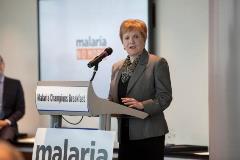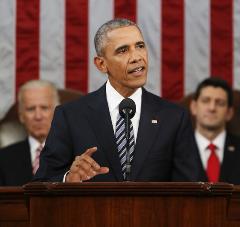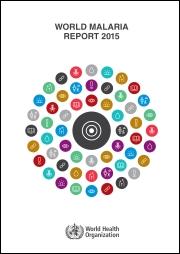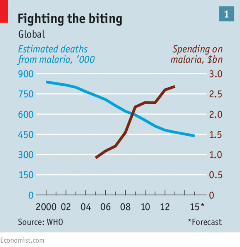Colleagues,
As we usher in 2016 and embark on a new era with the Sustainable Development Goals (SDGs), we stand at a pivotal moment in the long struggle against malaria that even recently seemed hopelessly intractable.
State of the Union
President Barack Obama delivered an inspiring and powerful message on the power of American leadership in achieving transformational global health goals once deemed too ambitious or too complex in his final State of the Union address on January 12th.
“American leadership means … rallying the world behind causes that are right. It means seeing our foreign assistance as part of our national security, not something separate, not charity … It’s the right thing to do, and it prevents the next pandemic from reaching our shores. Now, right now, we are on track to end the scourge of HIV and AIDS, that’s within our grasp, and we have the chance to accomplish the same thing with malaria, something I’ll be pushing this Congress to fund this year. That’s American strength. That’s American leadership. And that kind of leadership depends on the power of our example.”
The Obama Administration’s budget request for Fiscal Year (FY) 2017 included a $200 million increase for the U.S. President’s Malaria Initiative (PMI) composed of a $71 million increase in PMI base to $745 million, plus an additional $129 million one-time increase redirected from remaining Ebola emergency funding. In concert with Congress, PMI is prepared to increase our support to malaria-affected countries to further reduce malaria deaths and substantially decrease malaria illness, toward the long-term goal of elimination. With additional funding, PMI would:
- Launch and expand programs in four countries in West Africa. This would expand PMI’s reach to almost 70 million additional people at risk of malaria. PMI would add new programs in Cameroon, Cote D’Ivoire, and Sierra Leone and expand the program nationwide in Burkina Faso. With this expansion, the U.S. Government would be able to provide malaria prevention and control interventions to approximately 332 million people (92 percent) at risk across the West to Central African corridor from Senegal to Cameroon.
- Work with partners to accelerate elimination efforts in Cambodia and Zambia. It will not be easy; but it’s necessary to do if we are going to eradicate this disease. Cambodia is critical to control drug resistance, and Zambia is ambitious but achievable, and would catalyze elimination efforts elsewhere.
- Procure 13.7 million insecticide treated nets and ensure that 27 million people remain protected from malaria in sub-Saharan Africa.
- Accelerate research, development, and evaluation of new malaria tools focused on better diagnostics, vector control, and medicines.
World Malaria Report
In December, the World Health Organization released its World Malaria Report, which stated that malaria deaths in Africa have dropped 66 percent among all age groups and by 71 percent among children under 5 since 2000. Worldwide, more than 6 million lives have been saved, a vast majority of which have been children. You can read it here.
I was particularly struck by the finding that, while more than 6 million lives have been saved, a child dies from malaria almost every minute. While PMI has much to celebrate, there is still much work ahead. Hundreds of millions of people at risk of contracting malaria still do not receive the services they need.
Malaria Eradication: Breaking the Fever
When reading a piece in The Economist, I was reminded of the quote “What’s past is prologue” from Shakespeare in his play The Tempest – that the past is a preface to the future – we can’t forget the lessons of history. The Economist called on the global community to get firmly behind eradicating malaria, among a short list of other diseases. The read is a cautionary tale and a sober reminder that previous global eradication efforts did not halt global transmission. In fact, malaria persisted stubbornly. In several places where malaria had been on the brink of extinction, including both Sri Lanka and India, the disease came roaring back. And in much of sub-Saharan Africa, malaria eradication never really got started. Read the article here.
Malaria: A Prominent American Disease
As you all know, there is a great success story in the fight against malaria right here in the United States. I recently read Margaret Humphrey’s book, Malaria: Poverty, Race, and Public Health in the United States, and was gripped by this fascinating description of the toll that malaria exacted in North America over the course of three centuries. Except for mountainous areas and the deserts of the Southwest, malaria caused sickness, death, and economic waste across the United States. Even as late as the 1930s, the United States recorded millions of malaria cases. But with new tools and a concerted effort by the U.S. Public Health Service and the U.S. Centers for Disease Control and Prevention, by 1951, malaria was halted in the United States. Reading this account reaffirmed my sense of hope and also my resolve. We can and we must continue to harness the same relentless commitment and dogged determination to end malaria globally.
UNITAID Board Approves NgenIRS Project
The future shows both promise and peril. For the first time, some African nations are on their way to eliminating malaria, and fewer people on the continent are being infected than ever before. But, the tenacity of malaria means we must harness innovation and develop new tools to stay ahead of resistance in parasites and in mosquitoes.
 As you are aware, we are supporting research and development of insecticides for malaria control through support to the Innovative Vector Control Consortium (IVCC), an international public-private partnership with the aim of fostering new vector control products and tools for public health. The U.S. Government’s partnership with IVCC is central to global efforts to accelerate progress in malaria control and elimination. This is why I am especially pleased to share with you the exciting news that the UNITAID executive board just approved our plan to implement the Next Generation Indoor Residual Spraying (IRS) (NgenIRS) Project. On February 1, UNITAID and IVCC announced an initiative to expand the use of new anti-malarial insecticides to maintain the important role of mosquito control in combating malaria. The U.S. President’s Malaria Initiative is pleased to partner with UNITAID and IVCC to boost malaria control by developing and bringing new and effective insecticides at lower prices to spray walls in homes and fight growing insecticide resistance.
As you are aware, we are supporting research and development of insecticides for malaria control through support to the Innovative Vector Control Consortium (IVCC), an international public-private partnership with the aim of fostering new vector control products and tools for public health. The U.S. Government’s partnership with IVCC is central to global efforts to accelerate progress in malaria control and elimination. This is why I am especially pleased to share with you the exciting news that the UNITAID executive board just approved our plan to implement the Next Generation Indoor Residual Spraying (IRS) (NgenIRS) Project. On February 1, UNITAID and IVCC announced an initiative to expand the use of new anti-malarial insecticides to maintain the important role of mosquito control in combating malaria. The U.S. President’s Malaria Initiative is pleased to partner with UNITAID and IVCC to boost malaria control by developing and bringing new and effective insecticides at lower prices to spray walls in homes and fight growing insecticide resistance.
Malaria Champions Breakfast
 This past December, I attended Malaria No More’s Seventh Annual Champions Breakfast at the Newseum in Washington, D.C. Rep. Kay Granger (R-TX), chair of the House Appropriations Subcommittee on State and Foreign Operations, and Rep. Nita Lowey (D-NY), ranking member of the same committee, received The Malaria Vision Award for their leadership in Congress and commitment to helping save millions of lives from malaria. The event punctuated the critical need for continued bipartisan leadership and support from Congress. I especially wanted to relay to you that Dr. Fatoumata Nafo-Traoré, Executive Director of the Roll Back Malaria Partnership, expressed that PMI “serves as one of the best examples of truly bi-partisan commitment to global health and foreign aid.”
This past December, I attended Malaria No More’s Seventh Annual Champions Breakfast at the Newseum in Washington, D.C. Rep. Kay Granger (R-TX), chair of the House Appropriations Subcommittee on State and Foreign Operations, and Rep. Nita Lowey (D-NY), ranking member of the same committee, received The Malaria Vision Award for their leadership in Congress and commitment to helping save millions of lives from malaria. The event punctuated the critical need for continued bipartisan leadership and support from Congress. I especially wanted to relay to you that Dr. Fatoumata Nafo-Traoré, Executive Director of the Roll Back Malaria Partnership, expressed that PMI “serves as one of the best examples of truly bi-partisan commitment to global health and foreign aid.”
Looking Forward
As we were reminded during last year’s Ebola outbreak, if we are to tackle critical global challenges like Ebola or malaria, we need strong leadership – from individuals, communities, and partner countries to international partnerships – to fund, implement, and track progress. The global malaria community stands within the reach of achieving the goals that we once thought were unimaginable: ending deaths from malaria and then eliminating malaria from the globe. It is critically important that we build on this momentum.
Respectfully,

Tim
R.T. Ziemer
Rear Admiral, U.S. Navy (ret)
U.S. Global Malaria Coordinator




